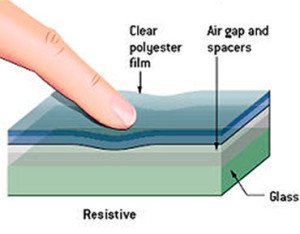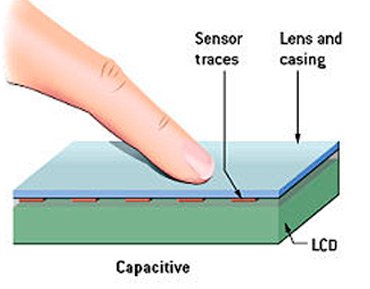Today I Learned: How Touchscreens Work! (And Why Some Work Better Than Others)

Technology is continuously getting better and better, and playing a bigger and bigger role in our lives.
One important aspect of technology that almost everyone takes for granted are Touchscreens!
Not too long ago, a touchscreen was something extraordinary and miraculous - and if you think about it, it is pretty revolutionary!
Our ancestors probably would have thought that there was magic involved when they saw that you could influence something on a screen just by touching it.
Today, countless things in our daily lives are controlled by touch screens - from the coffee machine we use in the morning, to the navigation system in our car when we go to work, of course almost all smartphones and tablets as well as many computers, but also things like vending machines, ATMs or self-checkout stations.
But there are a lot of differences when it comes to the technology and functionality of different touch screens.
As with everything in technology, touch screens have also gotten a lot more advanced and sensitive over time.

A method that had been used very frequently with touch screens a few years ago (and is partially still being used today) is called the "Resistive Touchscreen".
This technique involves 2 different layers of the touchscreen - It's usually a sheet of glass, topped with a layer of hard plastic material.
These two layers are then being covered with a thin coat of a metal compound that conducts electricity.
But the two layers are not simply stuck on top of each other. Tiny spacers, which are insulating, are placed in between to make sure that the touchscreen only gets a signal if you really touch it.
To activate the touchscreen feature, you'd have to press down on the first layer until it touches the second one.
This is the reason why you have to press very hard on most older touch screens, or those that are being used in public spaces - because these types of touchscreens are long-lasting and relatively cheap!
Once the two layers connect, the voltage at that exact point is being changed, and that's how a processor can know which position is being touched.

The other, more complex technology being used in smartphones, tablets and PCs is called "Capacitive Touchscreen".
Basically, those screens work with only one layer - glass, with an incredibly detailed grid of a conductive metal material.
The vertical lines of that grid are steadily transferring an electric current, while the horizontal lines are steadily observing this electric current.
And wherever the vertical and horizontal lines cross in the grid, there's an electrostatic field.
Since our fingers are conductive, that electrostatic field is being altered as soon as we touch the screen.
The grid lines are so tiny that the touch screen processor can know exactly where you put your finger on the screen. And you can even perform more complex tasks like touching with multiple fingers to zoom etc.
As you might have noticed from using your phone in the winter, these touch screens don't work with anything that's not conductive - so no gloves, for example.

Did you know about the complex technology behind touchscreens?!
Source for the TIL, Images: 1, 2, 3, 4
- Instagram -

© Sirwinchester
Really nice article bro, interesting and attention holding as always with valuable information. It's got me thinking why didn't I think of such a great topic lol. By the way, I actually have some gloves that I use which surprisingly keeps the electrical current conductive with my fingertips, therefore I can use my iphone5 just fine while still keeping my hands relatively warm, granted the gloves aren't thick as wooly mammoth für or anything ridiculous like that lol. They are just racing bicyclist gloves that do the job well. Anyway, again great post. Upvoted
thanks for your input!
Yes you're right, if the gloves aren't too thick of course you don't need specific ones.
that's a great tip!
You're very welcome
I purchased a Samsung Galaxy E Tab last spring, its close to a 10 inch screen , and seems to work really well so far! Is there a better one in a decent price range that you would recomend?! Thanks great post ! I never really thought it before untill i seen your blog! Great information! And some screens you can set them so that you can use gloves in winter you can do this in settings! Thanks for all the cool info! Steem on! ♨📱📲♨
I didn't know about those settings, only about specific smartphone-gloves, that's interesting!
On my phone its a ( Samsung Galaxy 4 ) if i touch the square in the top right cornerbeside the settings wheel, its where you can set your Wi- Fi , location, screen rotation, bluetooth , smart stay, smart pause etc. Well at the bottom on my phone theres a tab that says "touch sensitivity " if you tap on it it will increase the sensitivity so you can wear gloves in the winter! I use it alot on my jod as a security guard! We always wear gloves lol! Check it out! 📱
Not all phones have it i guess. I know my tablet doesnt have it.
I’ve actually always wondered WHY exactly iphone doesnt work with gloves. now I know lol
nowadays, even specific gloves for smartphone use have been invented - they have a material at the fingertips that is conductive!
I hate those touch screens where you have to press down really hard.. and then they don’t even respond because everyone has been hitting it so hard for it to finally work!
I know exactly what you mean!
@sirwinchester Interesting...well I am from an electronics engineering background so we play around with them and interface them to arduino microcontrollers for customer interactions and even home automation systems.
wow that sounds interesting!
There is other types as well, the ones that are built on that shatterproof glass they often use for kiosks and ticket machines, they work using light, i think, with emitters and sensors at the side of the glass that notice when there is more light bouncing back into the screen, and yes, they often are not very sensitive.
Also, resistive touch screens can work under water but capacitative ones cannot.
you are right, thanks for the input!
interesting that resistive touch screens even work completely under water, with your iphone screen you already notice that it doesn't work with just a few drops of rain!
I am sure there would be some depth limit for resistive sensors from water pressure, then you would have to resort to optical sensing systems, though, at that point you are probably too deep for just a scuba suit...
The issue with water is that it is electrostatically neutral, it has both positive and negative charge at the same time, because it is 'polar'. The capacitance effect for the touchscreen depends on on nonpolar materials, the same kinds of things that cause static electricity and such, and polar substances discharge the electrostatic charges. So it doesn't work, basically.
This post has been ranked within the top 25 most undervalued posts in the second half of Nov 17. We estimate that this post is undervalued by $16.67 as compared to a scenario in which every voter had an equal say.
See the full rankings and details in The Daily Tribune: Nov 17 - Part II. You can also read about some of our methodology, data analysis and technical details in our initial post.
If you are the author and would prefer not to receive these comments, simply reply "Stop" to this comment.
very interesting - you’re right, it’s something we use everyday but almost no one actually understands how it works
and that's the case with so many things!
you are right, 100 years ago people would’ve thought that touch screens are magic or witchcraft or something ..
totally! they wouldn't have believed their eyes!
yes I noticed those touchscreens with 2 layers too, sometimes you have to press down a lot otherwise the screen won’t recognize the touch
yes, I know that problem too well